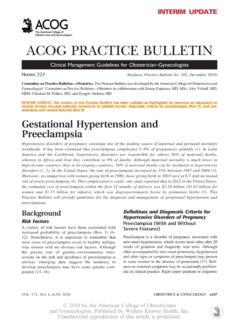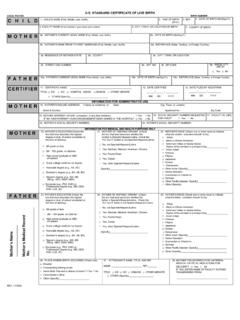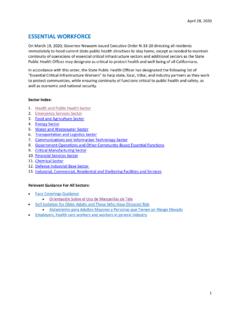Transcription of DESIGNER BABIES. A QUESTION OF ETHICS
1 DESIGNER BABIES. A QUESTION OF ETHICS . Justo Aznar MD, Ph D. Institute of Life s Science of the Catholic University of Valencia, Spain. INTRODUCTION. One of the most interesting biomedical advances brought about by new technologies in recent years, and with undoubtedly the greatest social repercussion, is preimplantation genetic screening1. This technique has two fundamental applications: to produce babies free of a hereditary or genetic disease that their parents may have2,3 and the production of DESIGNER babies4.
2 The term DESIGNER babies may be used to refer to a range of reproductive techniques including the use of sex selection techniques to prevent the birth of children with x-linked diseases, preimplantation genetic diagnosis to select for embryos free from genetic disorders, selection techniques for eggs, sperm or embryo donors with particular characteristics, and the enhancement of features such as intelligence, sporting ability or attractiveness. However, when discussing DESIGNER babies in this article, we will refer to a brother or sister produced by in-vitro fertilisation, capable of donating live-saving tissue to an existing child.
3 The production and subsequent use of DESIGNER babies has provoked widespread social debate, since trying to find a means to cure those sick siblings is something which is not only accepted, but also desired by a large part of society. 1. However, the production of DESIGNER babies entails specific medical5. and ethical6 problems. In this article, we will essentially address the latter. At the start of this reflection, I believe it is necessary to point out that for the parents of a sick child, producing a DESIGNER baby a healthy sibling from whom the hematopoietic tissue required to treat the sick child can be extracted, is a longing desire which, from here forward, regardless of our subsequent considerations, we award all the respect it deserves.
4 Before proceeding to study everything related to DESIGNER babies specifically, particularly the bioethical aspects, I believe it is necessary to state that, given that assisted reproductive technology is necessary to obtain them, their production has, in addition to other ethical difficulties, all the moral difficulties that this technique entails7. Brief historical summary The first cases in which preimplantation genetic diagnosis was considered for producing DESIGNER babies arose in the United States4, Australia8 and England9.
5 This possibility led the media in those countries to dedicate a lot of attention to the matter and thus thrust something into the public gaze that until then had been relegated to the privacy of specialised laboratories. The first DESIGNER baby was Adam Nash, produced by a team from the reproductive Genetics Institute in Chicago, led by Yuri Verlinski4. Adam was created to obtain his hematopoietic tissue, 2. which was necessary to treat Molly, his six-year-old sister, who suffered from Fanconi anaemia. After four failed attempts10, Adam was finally born on 29 August 2000 and the blood from his umbilical cord was able to be transplanted by Dr.
6 John Wagner's team11 to his sister in the first week of October that year, in the University Hospital, Minneapolis, Minnesota. Clinically, it could be confirmed that Molly's blood cells had improved significantly three weeks after the transplant11, which undoubtedly indicated that her bone marrow was recovering its functionality. Three years later her haematopoietic and immune systems were reported normal12. In 2002, also in the United States, the production of a second DESIGNER baby was also authorised; this time it was for an English couple who had moved to North America as this medical practice was prohibited in England at that time.
7 The sick child suffered from -thalassaemia major13. In 2001, in England, three families, the Hashmis, Whitakers and Fletchers, expressed their desire to have a DESIGNER baby10. The Hashmis had a son, Zain, who had -thalassaemia major14. After a series of legal changes15,16, in May 2003 the country's Court of Appeal authorised the production of the DESIGNER baby. The embryo produced by in-vitro fertilisation was transferred to Mrs. Hashmi, but unfortunately she miscarried in December 200310. After trying six cycles of in-vitro fertilisation treatment, the Hashmis decided to abandon any further attempts17.
8 The second English family, the Whitakers, who had a three-year old child who suffered from Diamond-Blackfan anaemia could not obtain 3. authorisation to produce their DESIGNER baby, so in October 2002. they travelled to Chicago, to the clinic where Adam Nash had been generated, with the intention of obtaining their DESIGNER baby, which they achieved in June 2004. The sick child had the transplant in July of the same year10. The third English family, the Fletchers, requested that the Human Fertilisation and Embryology Authority (HFEA) approve preimplantation genetic screening of in-vitro fertilisation embryos for treatment of their 2-year-old son, whose condition was the same as in the Whitaker case.
9 In September 2004, the HFEA approved a licence for the Fletchers to undertake treatment in the United Kingdom10. In Sweden, in 2004, the Swedish National Council of Medical ETHICS authorised the production of DESIGNER babies, but stated that the method should only be acceptable in cases when it could save lives that could not otherwise be saved18. This decision was not set into motion until July 200619. In 2007 the first case was authorised, selected from four applications that had reached the health authority.
10 It concerned a four-year-old boy called Felix. The boy's disease was adrenoleukodystrophy, a rare metabolic disease that causes damage to the myelin sheath of nerve cells18. On 28 May 2007, the National Board of Health and Welfare announced that it had authorised the other three cases18. Thus, Sweden became one of four countries that allow the production of DESIGNER babies. The others are Belgium, the United Kingdom and the United States. In Spain, the first DESIGNER baby was born in Tenerife in 2005, although she was produced in the Chicago reproductive Genetics Unit in 2004.









